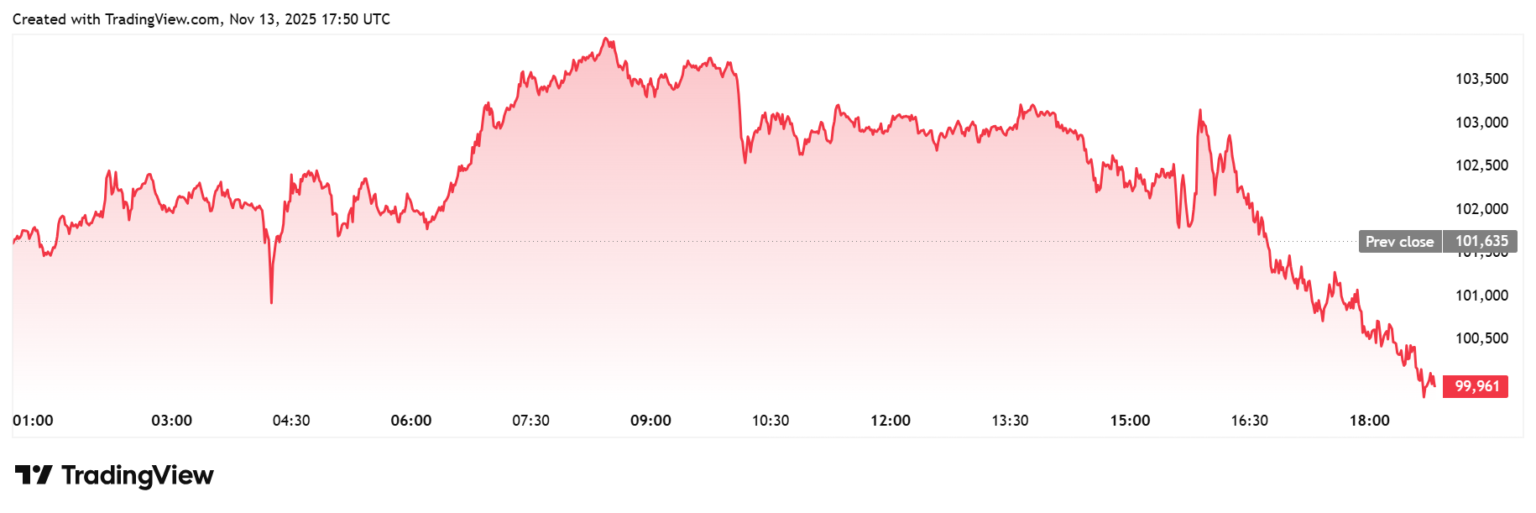Bitcoin Price Plummets: Analyzing the Recent Drop Below $100,000
The cryptocurrency market has witnessed a significant downturn with Bitcoin’s price falling below the critical psychological threshold of $100,000 for the second time in just two weeks. This decline comes surprisingly amid the anticipated bullish effects of the U.S. government reopening, which was expected to galvanize market sentiment. Instead, traders were left navigating through unexpected selling pressure that has sent BTC prices tumbling.
Market Reaction to Government Reopening
Data from TradingView indicates that Bitcoin reached a low of $99,300, marking a sharp decline following the reopening of the U.S. government, prompted by President Donald Trump’s signing of a short-term funding bill. Initially, the reopening held promise for a market boost, especially after the Senate passed the funding bill earlier that week. This anticipation drove Bitcoin prices to peak around $106,000. However, what unfolded was a classic "sell-the-news" scenario, demonstrating the unpredictable nature of market reactions.
Selling Pressure from Institutional Investors
One of the driving forces behind Bitcoin’s latest price drop has been significant selling pressure, specifically from institutional investors. Recent reports from CoinGape highlight that Bitcoin ETFs have experienced net outflows for eight out of the last eleven days, amounting to staggering losses of $577 million and $558 million recorded on November 4 and November 7, respectively. Such substantial withdrawals not only add to the selling pressure but also indicate a potential shift in institutional sentiment towards Bitcoin.
Flat Prices Amid Mini-Bear Phase
Further complicating the situation, research firm 10x Research has observed that Bitcoin’s price has remained stagnant, with buyers seemingly absent from the market. Analysts have noted that several bullish catalysts have failed to inspire renewed buying interest, leading to a concerning flat trend in Bitcoin prices. The research firm has classified the current market conditions as a mini-bear phase, suggesting that traders should prepare for further volatility ahead.
Uncertainty Surrounding Federal Reserve’s December Rate Cut
Another layer of complexity contributing to Bitcoin’s struggle is the growing uncertainty surrounding the Federal Reserve’s potential rate cut in December. Speculation around interest rates plays a vital role in crypto markets, as prior cuts led to significant price rallies. This year, Bitcoin experienced notable highs just before the Fed implemented rate reductions in September and October. However, with recent developments suggesting that the odds of a December cut have diminished, traders are likely to remain on the sidelines, awaiting clearer signals from the Fed’s upcoming FOMC meeting.
Liquidations Impacting Market Stability
The recent Bitcoin crash has led to massive liquidations, particularly of long positions, which traditionally show market confidence. CoinGlass data reveals an astonishing $140 million in positions liquidated within just an hour, with $138 million originating from long positions. In the past 24 hours, a total of $532 million has been liquidated, signaling a market rife with anxiety and a shift in trader strategy. As long positions are forced out, the selling pressure continues to mount, further destabilizing Bitcoin’s price.
Looking Ahead: A Cautious Approach to Bitcoin Investments
Given the current landscape, Bitcoin investors face a tricky environment characterized by fluctuating sentiments and external economic indicators. While historically, Bitcoin has been known for its volatility, the interplay of institutional selling, regulatory news, and macroeconomic factors is increasingly shaping current market conditions. For traders and investors alike, a cautious approach may be prudent, focusing on developing clarity regarding potential rate cuts and market sentiment shifts before making significant investment decisions.
In conclusion, as Bitcoin grapples with its recent price drop below $100,000, the combination of institutional selling, uncertainty around interest rates, and market sentiment shifts makes it a challenging time for investors. With no clear bullish signals in sight, it remains crucial for market participants to stay informed and adaptable in a rapidly shifting landscape.


